Finally the day had been arrived. After 3 days of trekking and camping in wilderness of The Himalayas, we were supposed to reach our final destination Roopkund Lake on the fourth day.
As suggested by our guide last night, we woke up around 03:30 AM in the early morning. I looked outside and it was completely dark with freezing cold. I looked at the others. They all were inside their sleeping bags. Who wanted to come out in that freezing cold? Obviously Nobody, but we couldn’t wait for more time. From last 4 days, we were trekking for that morning only.
Reluctantly, we stepped out from our sleeping bags. Outside the hut, it was completely dark. Then, I looked above the Himalayan peaks.In that pitch dark hours, those high Himalayan Peaks was shining like silver in the moonlight. It was an awesome view. There couldn’t be a better way to start our final day.
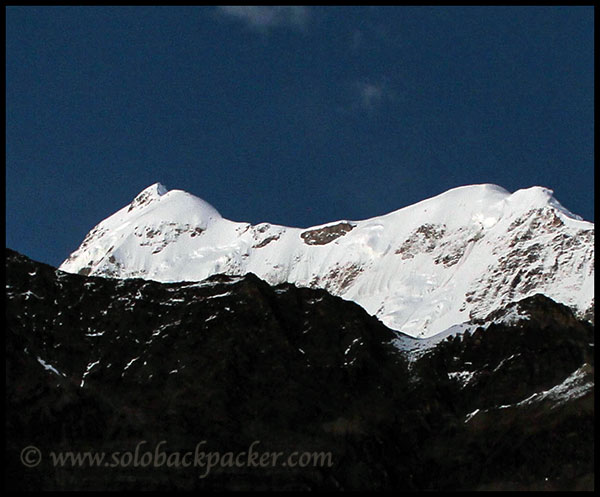
By 0415 AM, we were ready for the final trek to Roopkund. We moved ahead in the darkness with the help of our torches. The trail is filled with the stones blocks, so we had to move carefully. We didn’t face any problem for next an hour as it is an easy trail.
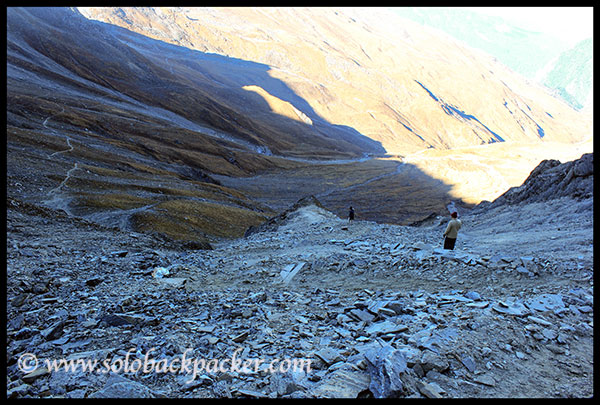
We reached Chhirianag, the area of serpentine steps made of slate rocks. From there, the last climb to Roopkund starts and it is really a tough trail. You have to move carefully on the steps that is full of loose stones and the trail is very narrow. During the snowfall, this trail becomes very dangerous, but during our trek, there was no snow. The climb was very steep and we got tired very soon. However, we moved slowly with frequent breaks. I again had the headache problem, the relatively lesser Oxygen definitely played a big role to exhaust all the energy quickly.
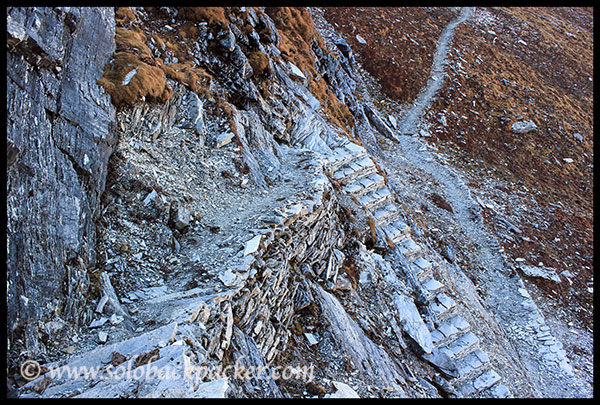
When I looked back towards Bhagwabasa, I saw the horizon was changing to orange colour. The sun was rising somewhere slowly. The valley was filled with white clouds. That view gave us a reason to take a longer break and to click some pictures.
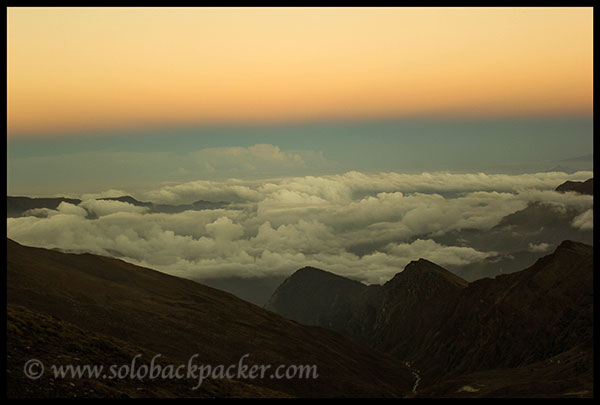
Finally, we reached at our most awaited destination in 3 hours from Bhagwabasa. There were no snow on the trail except the last 100 meters. Roopkund is a crater on a side of the mountain between Trishul Peak and Nandaghunti Peak. You can not have the first glimpse of the lake, unless you reach at the edge of the lake, even not from the 2-3 meters before the lake. When we reached there, it was completely frozen and covered by the snow. We couldn’t approach to the bottom (50 feet down) without a rope and ice axe, so we stayed at the top edge. It is a small lake and generally remains frozen throughout the year, expect 2-3 months in summer and monsoon.
I can say, at first glance Roopkund didn’t impress me at all. I trekked for four days from 8300 feet to 15689 feet, just to visit a frozen lake, that too a small one and there was no sign of much-talked skulls, bones and skeletons in that mysterious skeleton lake. There was a pile of stone on the upper corner, where we saw a skull and some bones. I tried hard to look down in the lake, so that I could see some more skulls, some skeletons, but no lucks. Either they were completely buried under the snow or majority of them were carried away by the scientists and other expediters. Though many people claim that the skeletons are still visible clearly under the water during the two months when the ice melts.
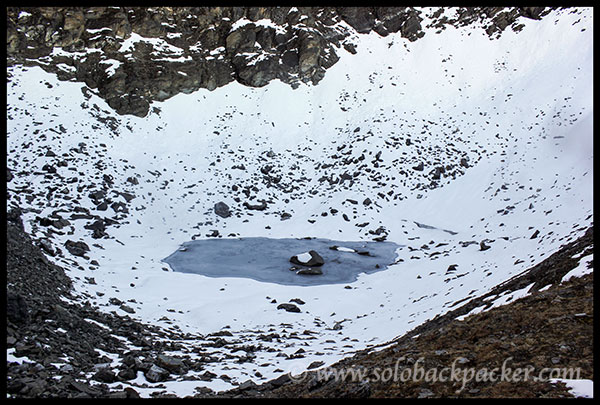
How those skeletons reached there and why, nobody has the exact answer. There was lot of myths and legends associated with Roopkund Lake:
Legend related to its name: When Goddess Durga (Parvati) killed the demon at Bedini Bugyal in her Kali Avtar, she was completely stained in the blood. Lord Shiva created this lake by his Trishul so that the goddess could bath. Parvati dipped herself in the blue waters and saw her beautiful reflection in the waters, which was why the lake was named Roopkund (Roop: Beauty, Kund: Lake).
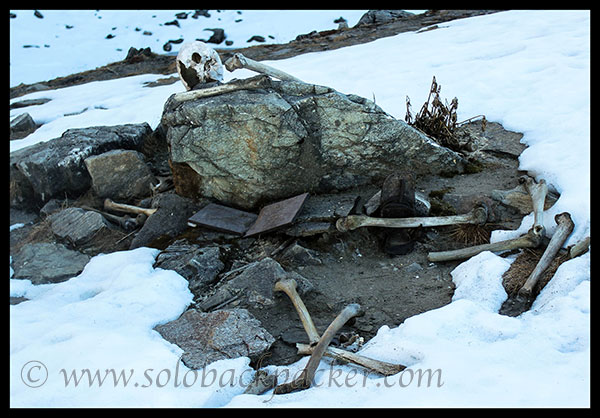
Myths related to the skeletons:
Myth 1: Some pilgrims were on their way to Kailash during Nanda Raaj Jaat Yatra. A fatal hailstorm killed all and buried them.
Myth 2: They were the traders moving to/from Tibet. However, there is no evidence that such trade route exist there at that time.
Myth 3: Firoz Shah Tuglaq’s Army lost their way and buried in a hailstorm.
Myth 4: Japanese soldiers lost their way and buried there at Roopkund.
Myth 5: General Zorawar Singh of Kashmir and his men made an unsuccessful attempt to invade Tibet in 1841. While returning back, they got caught in bad weather and died because of a hailstorm.
Myth 6: King Jasdhaval of Kannauj was on the pilgrimage to Nanda Devi with a large army. His pregnant wife was also with him. She gave birth to a girl child in a cave near the lake, spoiling the purity of this sacred land. The goddess Nanda Devi became very angry and sent a hailstorm that buried entire army alive.
Myth 7: They were the victim of an epidemic or a mass suicide ritual performed by the locals.
Scientific Research beyond these myths: Roopkund lake always remain a mystery because of the so many myths associated with it. In view of this, a scientific research was carried out by CCMB, Hyderabad using modern DNA fingerprinting analysis. That research unfolded many mysteries, but exact answer is yet to find out. The research concluded that those skeletons and bones are about 1200 years old (from 9th century AD) and there were at least 300-400 people, belonging to all age groups and containing male, female as well as children on their way to somewhere beyond Roopkund. DNA testing reveals that those skeletons also had family linkages. The tests showed that the human skeletons strewn at Roopkund had injuries on the skulls, suggesting that they may have been caught in an avalanche or a blizzard. It further reveals that there was two distinct ethnic group. One taller people belong to a particular ethnic group possibly living in the planes (might be the trekkers or pilgrims), where another shorter people , belonged to another group possibly living in the hills (might be the porters trekking with those trekkers/pilgrims). They all were died because of sudden impact of hailstones during the hailstorm.
Whatever was the reason and whoever they was, the truth is that almost 400 people vanished in that height of Himalayas and the world still don’t anything about them. We would not even know about them ever, if a forest ranger of Nanda Devi Game Reserve, H K Madhwal, did not reach there suddenly in 1942. These days, Roopkund is a very popular trekking destination, but history of that mysterious lake is still a mystery for many people.
I looked beyond the lake. One side is Bhagwabasa and nearby valleys completely covered by the white clouds. Other side of the lake is the high mountains and snow peaks. Junargali Pass is about 400 meters away from Roopkund and it normally take 30 minutes to reach there. The trail from Roopkund to Junargali Pass was completely covered with the snow. Other side of the pass is not visible from Roopkund, so you have to climb to Junargali to see what is there on the other side of the pass.
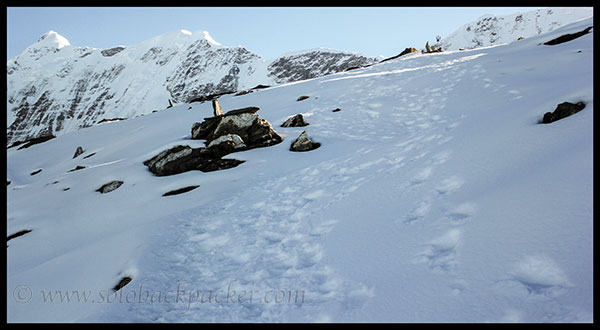
Because of the thick layer of the snow on the trail, our guide refused to go further without a rope and ice-axe. Sanjeev was not willing to go there also. Other two members of our team were very tired and yet to arrive at Roopkund. I had to make the decision alone. I wanted to see that what is there at the other side of Junargali. We trekked so hard to reach Roopkund and I couldn’t left the hope when Junargali was only 30 minutes (300-400 meters) away. I didn’t want to regret later, so I moved alone. There was deep slots in the snow made by some other visitors. The slots were big enough to fit my shoes. I walked on that slots with the help of my trekking pole. After 35 minutes of the slow and careful trekking, I was there at Junargali Pass. and It was a rewarding experience to trek there. I could see at the other side of the pass, completely covered in the snow. The base of Trishul peak was clearly visible. I was so closed to the Trishul Peak. It seemed that I could descend down and then climb on Trishul also, but I knew that was not possible. I was there for 20 minutes.I returned back to Roopkund. By that time both the remaining members were also arrived. I proposed to slide down on the snow, but everybody was against that. I dropped that idea.
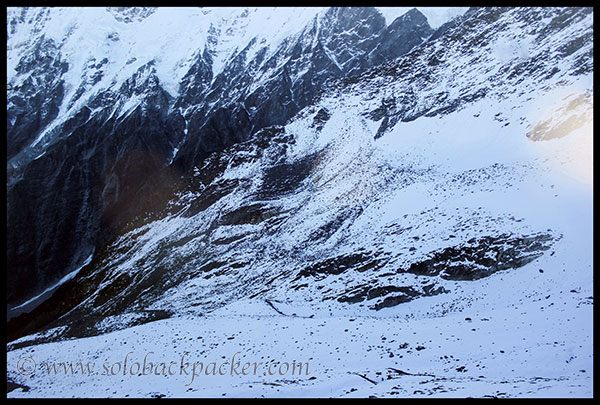
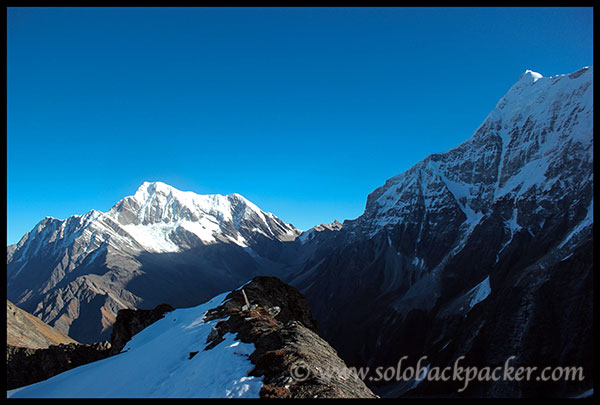
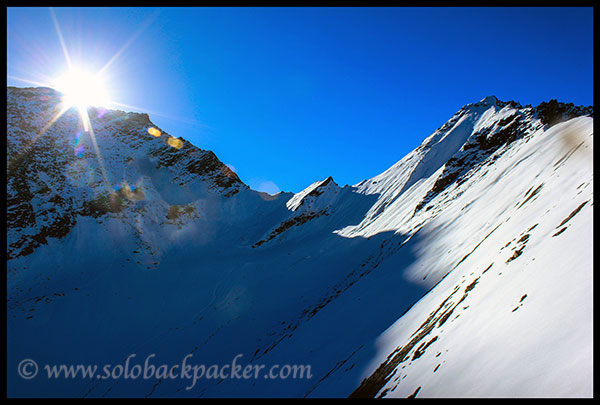
We moved around the lake and clicked our pictures. I was not much impressed by the appearance of that glacial lake, but there was so much joy and thrill on the trek route to the lake, that I didn’t have any regrets. Our journey to Roopkund was very enthralling and exciting because of the unparalleled beauty offered by the nature on that trek route in the form of dense forests, widespread meadows, snow-clad peaks, white clouds and beautiful mountains. There was a small temple near the lake, where we prayed for our well-being and thanked god to make that journey successful and memorable.
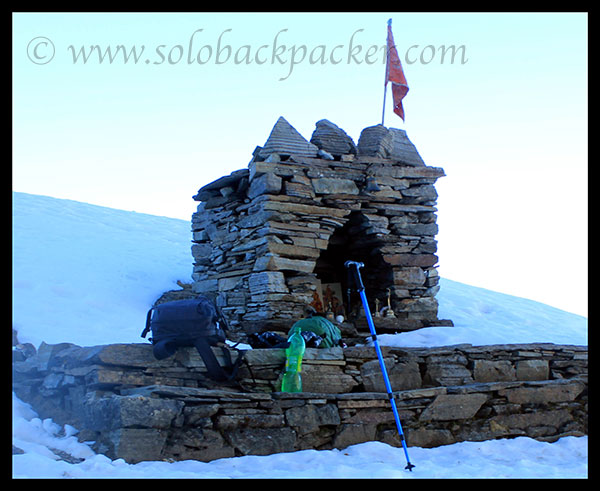
We spent 30 more minutes there and then started our descend to Bhagwabasa. On the way, I searched for the scared flower, Brahma Kamal. Too my surprise, they were in abundance along the trail. I was unable to spot them during another trek to Hemkund Sahib, but I found a lot of flowers on this trek. That was not a blossom season for them, so they appeared in pale yellow colour, but still they were very beautiful.
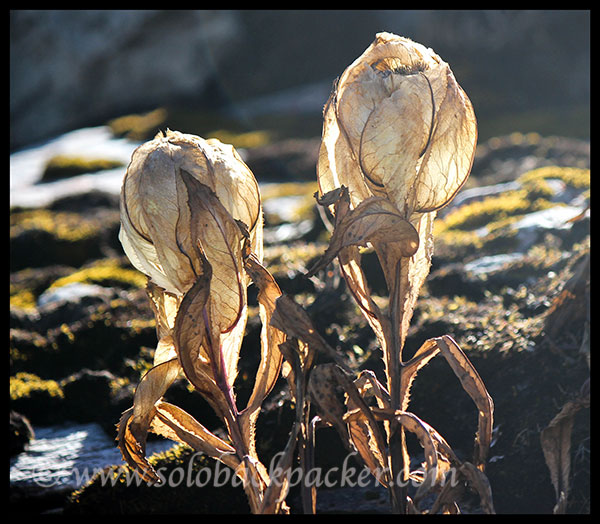
One km before Bhagwabasa, I found a person from our camp, who was collecting water in a gallon. It was a very narrow source of stream and it generally took him one hour to fill a single gallon. The water is so much scarce at Bhagwabasa.
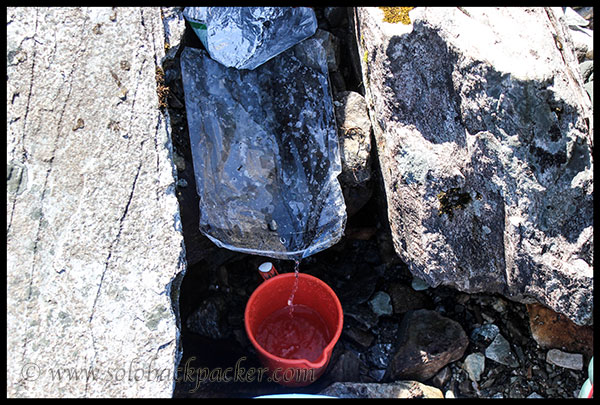
We reached Bhagwabasa in 2 hours. We stayed there and took some rest before starting our onward trek to Pathar Nachauni. We left Bhagwabasa and still there was no other group arrived. When we reached Kalu Vinayak and saw the other side, the valley near Pathar Nachauni was completely filled with clouds. It was again a beautiful view and looked like we were watching the clouds from an airplane’s window.
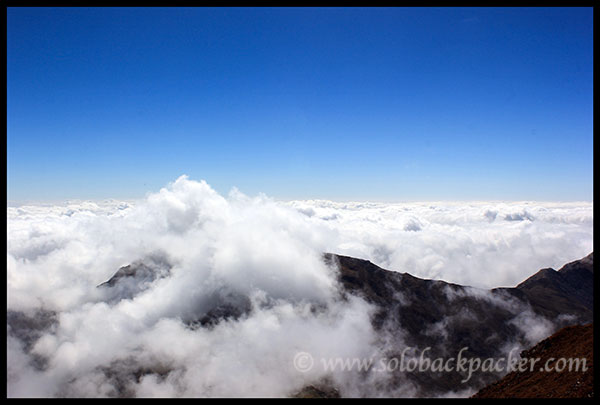
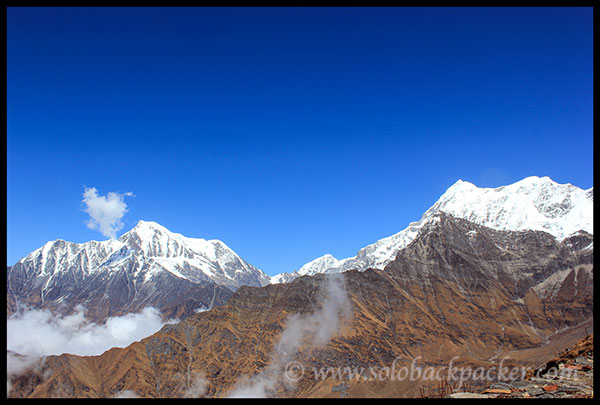
We met many people after Kalu Vinayak, who were trekking to Bhagwabasa. Some of them were intended to visit Roopkund and then return to Bedini on the same day. We were not sure about our night halt. As per plan, we were supposed to stay at Pathar Nachauni, but some people wanted to stay at Bedini. We reached Pathar Nachauni at 2 PM and found a vacant hut of the Forest Deptt. I didn’t wish to trek further. So, we finally decided to stay at Pathar Nachauni.
Later, I sighted two Bhural (mountain goat) in front of our hut. Those mountain goats were the only notable thing, that we could not sight till then in Roopkund Trek. After sighting those two Bhurals, our trek to Roopkund seemed completed. However, we still had two days of downward trekking left in our itinerary.
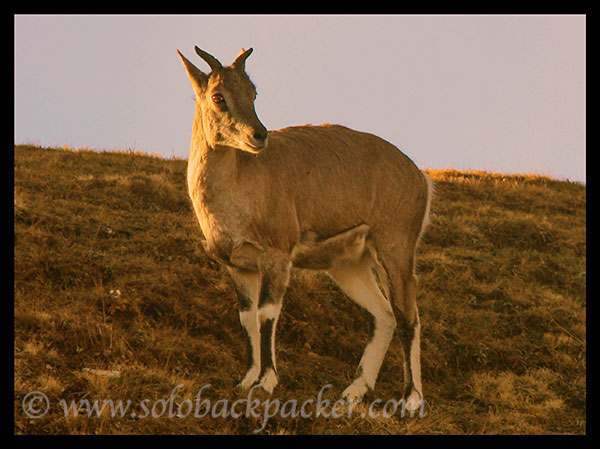
Next day, we trekked the maximum distance in a single day from Pathar Nachauni to Didna Village via Bedini Bugyal and Ali Bugyal. In my next post, I will take you to the journey of that beautiful meadow, Ali Bugyal and dense forest of Pine and Oak Trees near Didna village.


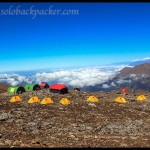
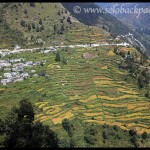
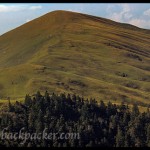
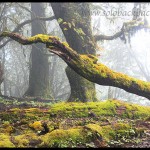
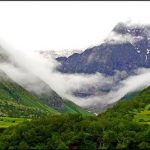
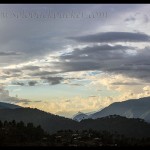
Hi. How difficult is it to descend through the stairs you mentioned, on the way back from Roopkund to Bhagwabasa?
It’s doable with good trekking shoes. Just take some precautions.
you have written your experience to Roopkund in a very brief yet captivating manner. I could not stop but read the whole article.
Thank you. Hope you enjoyed this virtual trek to the lake and Junargali Pass. Did you visit it already? 🙂
spellbound, can feel the excitement just excellent.